*Update: I modified the code after the suggestions of @jlandercy. Further, the code now solves a differential equation shown below to optimize the flow of my product gas. Sample data is updated.
I am trying to fit a two-site Langmuir Hinshelwood model which I derived, (basically, rate as a function of pressures of reactants and products) to my experimental data. The model converges, but changing the initial parameters can make a stark difference. The problem is those parameters matter for my analysis. Since I am comparing different models, the model vs experiment % fit depends on these parameters (K1, K2 ...).
I wanted to know if there is any other method to check that a particular set of parameters are better than the others (obviously a particular combination will give a slightly better-fit percentage, but that, in my opinion, may not the deciding criteria). The MSE landscape calculation, as suggested by @jlandercy, has been useful in understanding the convexity relationship between different parameters, however, I could not extract more information from them to move ahead and fix my K parameters.
P.S.: The other models are way simpler, in terms of mathematics, than this model. So, if I this is well understood, I should be able to compare the models with decent parameter accuracy. Thanks in advance for the help!
import numpy as np
import pandas as pd
import matplotlib.pyplot as plt
from scipy.optimize import least_squares
# Step 1: Read experimental data
data1 = pd.read_excel("Local address of file")
# Extract the partial pressures (A, B, C) and the reaction rate
pp = data1.iloc[:49, 2:5].values
TT = data1.iloc[:49, 16].values
rr = data1.iloc[:49, 17].values
F0 = data1.iloc[:49, 5:10].values
W = data1.iloc[:49, 15].values
FF = data1.iloc[:49, 10:15].values
data = np.hstack((pp, F0, FF, W.reshape(-1,1), TT.reshape(-1,1)))
#-----------------------------------------------------------------------------
class Kinetic:
"""Langmuir-Hinshelwood Two-Site Kinetic Model Solver"""
R = 8.314 # J/mol.K
Ea = 45000 # J/mol
theta_g = [0.9, 0.1] # 1
w = np.linspace(0,1,100)
@staticmethod
def k3(flow, data, K1, K2, k4, K5, k0):
"""Arrhenius estimation for k3"""
pA, pB, pC, F0_a, F0_b, F0_c, F0_ar, F0_h, FF_a, FF_b, FF_c, FF_ar, FF_h, mg, T = data
return k0 * np.exp(-Kinetic.Ea / (Kinetic.R * T))
@staticmethod
def s(flow, data, K1, K2, k4, K5, k0):
"""Partial kinetic rate"""
pA, pB, pC, F0_a, F0_b, F0_c, F0_ar, F0_h, FF_a, FF_b, FF_c, FF_ar, FF_h, mg, T = data
#Calculating gas pressures at every position of PFR reactor
pA_t = flow[0] / np.sum(flow)
pB_t = flow[1] / np.sum(flow)
pC_t = flow[2] / np.sum(flow)
k3 = Kinetic.k3(flow, data, K1, K2, k4, K5, k0)
return (K1 * K2 * k3 / k4) * pA_t * pB_t
@staticmethod
def equation(x, y, C, s):
return 1/(1 + C + np.sqrt(s*y/x)) - x
@staticmethod
def system(theta, flow, data, K1, K2, k4, K5, k0):
"""Isothermal coverages system"""
pA, pB, pC, F0_a, F0_b, F0_c, F0_ar, F0_h, FF_a, FF_b, FF_c, FF_ar, FF_h, mg, T = data
t0, t1 = theta
s = Kinetic.s(flow, data, K1, K2, k4, K5, k0)
pA_t = flow[0] / np.sum(flow)
pB_t = flow[1] / np.sum(flow)
pC_t = flow[2] / np.sum(flow)
C0 = K2 * pB_t
C1 = K1 * pA_t + pC_t / K5
return np.array([
Kinetic.equation(t0, t1, C0, s),
Kinetic.equation(t1, t0, C1, s),
])
@staticmethod
def _theta(flow, data, K1, K2, k4, K5, k0):
"""Single Isothermal coverages"""
solution = fsolve(
Kinetic.system,
Kinetic.theta_g,
args=(flow, data, K1, K2, k4, K5, k0),
full_output=False
)
if not(all((solution >= 0) & (solution <= 1.0))):
raise ValueError("Theta are not constrained to domain: %s" % solution)
return solution
@staticmethod
def theta(flow, data, k1, k2, k4, k5, k0):
"""Isothermal coverages"""
return np.apply_along_axis(Kinetic._theta, 0, flow, data, k1, k2, k4, k5, k0)
@staticmethod
def r1(flow, w, data, K1, K2, k4, K5, k0):
"""Global kinetic rate"""
pA, pB, pC, F0_a, F0_b, F0_c, F0_ar, F0_h, FF_a, FF_b, FF_c, FF_ar, FF_h, mg, T = data
pA_t = flow[0] / np.sum(flow)
pB_t = flow[1] / np.sum(flow)
pC_t = flow[2] / np.sum(flow)
#print(pA)
k3 = Kinetic.k3(flow, data, K1, K2, k4, K5, k0)
t0, t1 = Kinetic.theta(flow, data, K1, K2, k4, K5, k0)
v=np.array([-1,-1, 1, 0, 0])
#v = v[:, np.newaxis] # Convert v to a 2D array with shape (5, 1)
return ((K1 * K2 * k3) * pA_t * pB_t * t0 * t1) * v
@staticmethod
def dFdm(data, K1, K2, k4, K5, k0):
"""Global kinetic rate"""
residual =[]
sq=[]
for i in data:
pA, pB, pC, F0_a, F0_b, F0_c, F0_ar, F0_h, FF_a, FF_b, FF_c, FF_ar, FF_h, mg, T = i
F0 = np.array([F0_a, F0_b, F0_c, F0_ar, F0_h])
FF = np.array([FF_a, FF_b, FF_c, FF_ar, FF_h]) # Final Experimental flows
flow = odeint(Kinetic.r1, F0, Kinetic.w, args = (i, K1, K2, k4, K5, k0))
flow_pred = flow[-1,2] # Predicted final model flows
res = (flow_pred - FF_c)*1000
residual.append(res)
return residual
bounds=((0, 0, 0, 0, 0), (np.inf, np.inf, np.inf, np.inf, np.inf))
initial_guesses = [8, 8, 50, 16, 6]
result = least_squares(lambda k: Kinetic.dFdm(data, *k), x0=initial_guesses, bounds=bounds, ftol=1e-14)
K1_fit, K2_fit, k4_fit, K5_fit, k0_fit = result.x
print(K1_fit, K2_fit, k4_fit, K5_fit, k0_fit)






